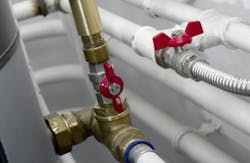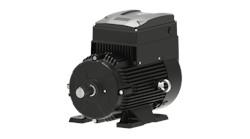The objective of this article is to determine how to properly evaluate the means to be used in sizing of the interconnecting piping among the several vessels comprising the overall system. These vessels consist of such items as the automated washer, a receiving tank connected to the washer and such auxiliary equipment as sinks and showers — all of which discharge water laden with particulate matter that could possibly consolidate, causing piping blockages. These blockages would require the removal through the use of appropriate cleaning tools or, perhaps, partially disassembling the piping.
System description and objectives
The household system, being considered herein, consists primarily of a discharge tank and a semi-automatic washer assembly. The washer assembly is provided with removable, hot and cold fresh water connections and a removable wastewater connection attached to a wastewater discharge or holding tank. The holding tank is also provided with a permanent wastewater pipeline discharging to a sewer as well as with a separate hand-loaded dryer.
The overall system is supplied with additional household items such as toilets, multiple sinks and showers. These items will be considered as well, since wastewater from all of these materials is provided with wastewater piping, and they are ultimately connected to a common sewer line. It is important to mention the direct gravity flow of wastewater is transferred by the pipeline from the discharge or holding tank to the sewer, as it is important to note the same for the sinks, showers and other such items, separate from the washer assembly. Pumped flow, however, is used for the transfer of wastewater from the washer to the discharge tank.
Operational procedure
The procedureused to operate the semi-automatic washer discharge tank assembly consists first of properly making a selection from the available operational variables, which are comprised of: The material to be washed, such as cotton, knit fabrics or delicate fabric materials; these materials are then followed by temperature of the water to be used; the degree to which the fabric is soiled; and the water level to be used for the washer.
After depositing detergent with the fabrics to be washed, the washer is started and the remainder of the operating conditions that need be followed is automated.
The wash tank is first filled with clean water and the fabrics are cleaned by agitation. This is followed by the pump transfer of the wastewater to the discharge tank, which then discharges the water by gravity to the sewer line, through appropriately sized piping, while the fabrics are dewatered by rapid rotation of the inner tank of the washer. This processing sequence is repeated with a second input of clean water for rinsing, followed by dewatering the wash in order to complete, stop and end the cycle.
Overall system components
Figure 1 provides a schematic, partial general arrangement of the items discussed earlier regarding the description of the system.
Please add to Figure 1:
Item Description
(1) Semi-automatic washer, provided with an inner vessel with sidewall perforations and a motor-driven agitator for washing, as well as with the ability to rotate rapidly to dewater the wash after wastewater is transferred by the pump to the discharge tank.
(2) Discharge tank — a holding tank from which water is drained by gravity to the sewer.
(3) Inner vessel of washer.
(4) Clean wash water hot and cold water inlets and outlets and the wastewater discharge outlet, provided with control valves.
(5) Water source for clean water.
(6) One-inch diameter transfer line for a high velocity transfer of wastewater to the discharge tank.
(7) Two-inch diameter piping from the shower, sink and discharge tank to the sewer with discharge by gravity only.
(8) Sewer line.
(9) Shower water discharge outlet.
(10) Sink water discharge outlet.
(11) Maximum discharge tank water level.
Wastewater discharge from a washer and discharge tank
Examination of the discharge wastewater flow revealed that the contents consisted of rather small, elongated fibrous pellets, 1/8 to 1/4 inch in diameter with a small length to diameter ratio of perhaps two to one.
Although the concentration of the pellets in the washer assembly was not measured and varied with the type of input fabric materials processed, the analysis, considered herein, did not require consideration of the small concentrations of this variable of utmost importance — the belief being that the density of the particles and the velocity of the water in the piping are being considered more important. However, efforts were made initially to filter the washer discharge material to avoid possible clogging of the piping.
This procedure proved unacceptable, but because the filter openings needed for filtration were rather small in size due to space limitations restricting the size of the filter, and because the particulates were somewhat fibrous, the filters quickly clogged and required replacement. Cleaning of the filters was not considered an option because of the fibrous nature of the deposits, which rendered a cleaning operation too time consuming and impractical.
Calculations
Because of the filtering difficulties involved, it was thought that clogging of the wastewater piping might best be avoided by maintaining turbulent flow in the piping. Whether turbulent or laminar flow exists in the interconnecting piping of the subject installation is easily determined by the calculation of the Reynolds number, or Re. Thus, it has been concluded by others that if the Re is less than 2,100, laminar flow prevails and if greater than an Re of 2,100, turbulent flow prevails. Pertinent equations for making this determination are as follows:
- Re = (D)(V)(Liq.Dens./(0.000672)(Liq.Visc.)
- (Liq.Press.Drop) = (2)(f )(L)(Va)2/(g)(D)
- (Ent.+Ex.Loss) = (1.5)(Va)2/(2)(g)
- (Vert.Liq. Height) = (Liq.Press.Drop) + (Ent+Ex.Loss)
Table 1: Nomenclature (extract out)
Re = Reynolds number
D = Inside pipe diameter, feet
V = Liquid velocity, feet per second
Liq. Dens. = Liquid density, pounds/cubic feet
Liq. Visc. = Liquid viscosity, centipoise
Liq. Press.Drop = Frictional loss inside pipe, feet
f = Frictional pipe loss coefficient, .005 used in this calculation
L = Total pipe length, feet
Va = Inside pipe velocity
g = 32.2
Ent.+ Ex. Loss = Loss due to entering and leaving the pipe, feet.
Vert. Liq. Height = feet.
Summary
In the above application, it has been assumed that the particulates are not sticky and are not capable of adhering to the inside surfaces of the piping; the density of the particulates is not much greater than that of the liquid water carrying fluid; and the particulates are not long, thin or highly flexible and are not capable of entanglement, such as hair, so as to form large size bundles of pipe blocking debris. Furthermore, the internal pipe flow in all cases, as determined by the Re, must be greater than 2,100 — the transition from laminar to turbulent flow.
The calculation method proposed in this article has indicated that this is indeed the case: An Re of 2,100 or greater having been calculated, as shown in Table 2, for all of the arrangements comprising the overall system.
Table 2
System Reynolds number (Re)
Discharge piping from holding or discharge 3,000
tank to sewer
Discharge piping from shower to sewer 200,000
Discharge sink to sewer 150,000
That turbulent flow in a pipeline in this particular service, as described herein, remains to be seen as a means of avoiding pipeline clogging. However, as of three months in service with this system, there has been no reported clogging of the piping, during which washing was performed almost daily.
Alan Cross received a B.Ch.E. degree from the City College of New York and an M.S.Ch.E. degree from NYU Polytechnic School of Engineering of Brooklyn. Cross is a long-time member of the American Institute of Chemical Engineers and has more than 30 years of experience in the design of direct fired process heaters, while in the employment of the Abb Lummus Heat Transfer Division of Abb Lummus Crest located in Bloomfield, New Jersey. He has since written and published about 10 design articles relating to heat transfer, fluid flow and a variety of other topics, and has authored and received five U.S. patents.


